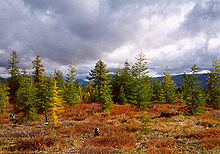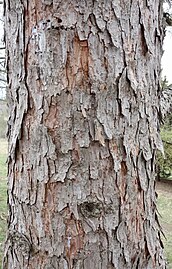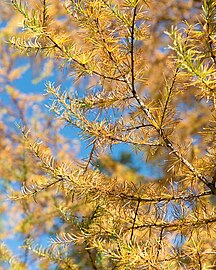Larix gmelinii
| Dahurian larch Larix gmelinii | |
|---|---|

| |
| Dahurian larch forest, Kolyma region, Arctic northeast Siberia | |
| Scientific classification | |
| Kingdom: | Plantae |
| Clade: | Tracheophytes |
| Clade: | Gymnospermae |
| Division: | Pinophyta |
| Class: | Pinopsida |
| Order: | Pinales |
| Family: | Pinaceae |
| Genus: | Larix |
| Species: | L. gmelinii
|
| Binomial name | |
| Larix gmelinii | |
Larix gmelinii, the Dahurian larch or Gmelin larch, is a species of larch native to eastern Siberia and adjacent northeastern Mongolia, northeastern China (Heilongjiang), South Korea and North Korea.
Description
Larix gmelinii is a medium-sized
The cones are erect, ovoid, 1–2 cm (rarely 2.5 cm) long, with 15–25 moderately reflexed seed scales; they are green (rarely purple) when immature, turning brown and opening to release the seeds when mature, 3–5 months after pollination. The old cones commonly remain on the tree for many years, turning dull grey-black.
Taxonomy and systematics
The scientific name honours Johann Georg Gmelin. Due to the species' variability, it has acquired numerous synonyms in the botanical literature, including L. cajanderi, L. dahurica, L. kamtschatica, L. komarovii, L. kurilensis, L. lubarskii, L. ochotensis.
Dahurian larch intergrades with the closely related Siberian larch L. sibirica of central and western Siberia where their ranges meet along the Yenisei Valley; the resulting hybrid is named Larix × czekanowskii.
Varieties
As of April 2022[update], Plants of the World Online accepts four varieties:[2]
- Larix gmelinii var. gmelinii. Most of the species' range, from the Kamchatka.
- Larix gmelinii var. japonica. The Kuril Islands and Sakhalin.
- Larix gmelinii var. olgensis. North Korea, Heilongjiang, and the Sikhote-Alin mountains of Primorsky Krai, Russia. Sometimes treated as a distinct species Larix olgensis.[3]
- Wutai Shan mountains west of Beijing, separated from typical L. gmelinii by about 1000 km, and differs in having larger (2–4 cm) cones with more scales.
Ecology and uses

Larix gmelinii forms enormous forests in the eastern Siberian
Dahurian larch is occasionally grown in botanical gardens in Europe and North America; it is not an easy tree to grow in areas with mild winters as it is adapted to a long period of winter rest; the warm winter weather in Britain can tempt it into leaf as early as the start of January, with the tender young leaves then being killed by the next frost. In its native region, daily minimum temperatures above freezing do not occur until late May or June, with no further frost until the brief summer is over.
Larix gmelinii cone scales are used as food by the
Gallery
-
Young female cone and emerging needles
-
Bark
-
Short shoots, just after bud break
-
Shoots in fall
-
Larix gmelinii var. olgensis in fall, Arnold Arboretum of Harvard University, accession #365-97*A.
-
Old female cone
References
- . Retrieved 19 November 2021.
- ^ "Larix gmelinii (Rupr.) Kuzen." Plants of the World Online. Royal Botanic Gardens, Kew. Retrieved 2022-04-21.
- ^ "Larix olgensis". Germplasm Resources Information Network. Agricultural Research Service, United States Department of Agriculture. Retrieved 24 December 2017.
- ^ "Поспелова Е. Б., Поспелов И. Н. Лиственница Гмелина. Флора Таймыра (Информационно-справочная система)". Archived from the original on 2017-02-22. Retrieved 2016-10-08.
- ISBN 9780316042918.
It survives the winter cold of the far north, standing in the open at temperatures of ninety below zero, not counting windchill. ... Make no mistake: this is one tough tree.
- ^ Byazrov, L.G. Самое старое дерево России растет в Якутии [The oldest tree in Russia grows in Yakutia]. БОТАНИКА (in Russian). Archived from the original on 2007-09-29.
External links
- Larix gmelinii images at the Arnold Arboretum of Harvard University Plant Image Database
- "Larix dahurica var. Principis Rupprechtii China." Library Featured Images, Arnold Arboretum of Harvard University website, 30 October 2014. Accessed 7 May 2020.
- Gymnosperm Database: Larix gmelinii
- images (Larix gmelinii var. gmelinii)







